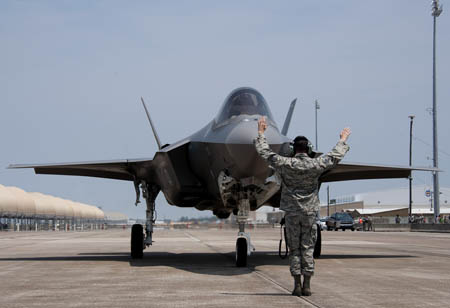 The Air Force’s aircraft procurement plan may not be realistic, as the service contends with a new age of flat-lining, and possibly even declining, defense budgets, said Todd Harrison, a senior fellow for defense budget studies at the Center for Strategic and Budgetary Assessments. In the 2020s, the KC-46A tanker “will be in full-rate production,” the next-generation bomber “will be ramping up to full-rate production,” and the F-35 strike fighter “will still be in full-rate production,” said Harrison Monday while briefing reporters in the think tank’s Washington, D.C., office. “I don’t see how the Air Force can handle, budget-wise, all of those programs being in full-rate production at the same time,” he said. Even if the budget is not cut, funding three major acquisition programs simultaneously will be “impossible” without “major sacrifices” in other areas, he said. More than likely, the Air Force will have to cut back the number of units procured—a move that would drive down total program costs, but force the costs per unit to go up, he said. Harrison’s discussion coincided with the release of the CSBA study that he authored analyzing the Obama Administration’s Fiscal 2012 defense budget request.
The Air Force’s aircraft procurement plan may not be realistic, as the service contends with a new age of flat-lining, and possibly even declining, defense budgets, said Todd Harrison, a senior fellow for defense budget studies at the Center for Strategic and Budgetary Assessments. In the 2020s, the KC-46A tanker “will be in full-rate production,” the next-generation bomber “will be ramping up to full-rate production,” and the F-35 strike fighter “will still be in full-rate production,” said Harrison Monday while briefing reporters in the think tank’s Washington, D.C., office. “I don’t see how the Air Force can handle, budget-wise, all of those programs being in full-rate production at the same time,” he said. Even if the budget is not cut, funding three major acquisition programs simultaneously will be “impossible” without “major sacrifices” in other areas, he said. More than likely, the Air Force will have to cut back the number of units procured—a move that would drive down total program costs, but force the costs per unit to go up, he said. Harrison’s discussion coincided with the release of the CSBA study that he authored analyzing the Obama Administration’s Fiscal 2012 defense budget request.
Pentagon Releases Cost of Living, BAH Rates for 2026
Dec. 30, 2025
The Pentagon will pay cost of living allowances to 127,000 service members in the continental U.S. in 2026, an increase of 66,000 members in 2025. Airmen and Guardians across the U.S. will also receive an average increase of 4.2 percent for their Basic Housing Allowance, compared to the 5.4 percent…

